Correlation between antimicrobial resistance and virulence In Klebsiella pneumoniae
- 格式:pdf
- 大小:364.45 KB
- 文档页数:9
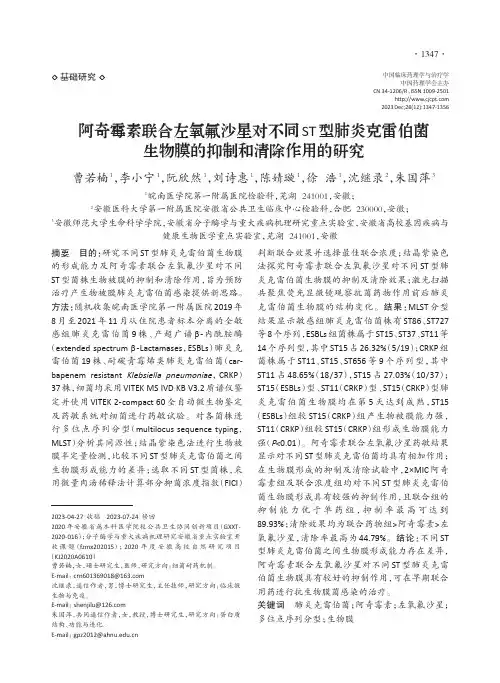
◇基础研究◇摘要目的:研究不同ST 型肺炎克雷伯菌生物膜的形成能力及阿奇霉素联合左氧氟沙星对不同ST 型菌株生物被膜的抑制和清除作用,旨为预防治疗产生物被膜肺炎克雷伯菌感染提供新思路。
方法:随机收集皖南医学院第一附属医院2019年8月至2021年11月从住院患者标本分离的全敏感组肺炎克雷伯菌9株、产超广谱β-内酰胺酶(extended spectrum β-Lactamases ,ESBLs )肺炎克雷伯菌19株、耐碳青霉烯类肺炎克雷伯菌(car-bapenem resistant Klebsiella pneumoniae ,CRKP )37株,细菌均采用VITEK MS IVD KB V3.2质谱仪鉴定并使用VITEK 2-compact 60全自动微生物鉴定及药敏系统对细菌进行药敏试验。
对各菌株进行多位点序列分型(multilocus sequence typing ,MLST )分析其同源性;结晶紫染色法进行生物被膜半定量检测,比较不同ST 型肺炎克雷伯菌之间生物膜形成能力的差异;选取不同ST 型菌株,采用微量肉汤稀释法计算部分抑菌浓度指数(FICI )判断联合效果并选择最佳联合浓度;结晶紫染色法探究阿奇霉素联合左氧氟沙星对不同ST 型肺炎克雷伯菌生物膜的抑制及清除效果;激光扫描共聚焦荧光显微镜观察抗菌药物作用前后肺炎克雷伯菌生物膜的结构变化。
结果:MLST 分型结果显示敏感组肺炎克雷伯菌株有ST86、ST727等8个序列,ESBLs 组菌株属于ST15、ST37、ST11等14个序列型,其中ST15占26.32%(5/19);CRKP 组菌株属于ST11、ST15、ST656等9个序列型,其中ST11占48.65%(18/37),ST15占27.03%(10/37);ST15(ESBLs )型、ST11(CRKP )型、ST15(CRKP )型肺炎克雷伯菌生物膜均在第5天达到成熟,ST15(ESBLs )组较ST15(CRKP )组产生物被膜能力强,ST11(CRKP )组较ST15(CRKP )组形成生物膜能力强(P <0.01)。
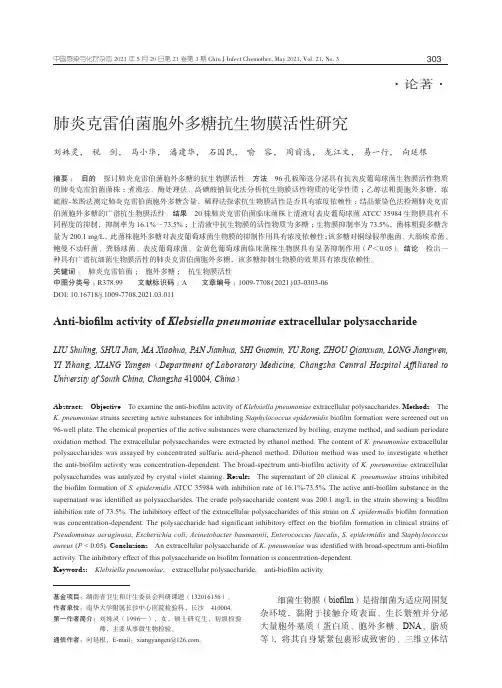
肺炎克雷伯菌胞外多糖抗生物膜活性研究刘姝灵, 税 剑, 马小华, 潘建华, 石国民, 喻 容, 周前选, 龙江文, 易一行, 向延根摘要:目的探讨肺炎克雷伯菌胞外多糖的抗生物膜活性。
方法 96孔板筛选分泌具有抗表皮葡萄球菌生物膜活性物质的肺炎克雷伯菌菌株;煮沸法、酶处理法、高碘酸钠氧化法分析抗生物膜活性物质的化学性质;乙醇法粗提胞外多糖,浓硫酸-苯酚法测定肺炎克雷伯菌胞外多糖含量,稀释法探索抗生物膜活性是否具有浓度依赖性;结晶紫染色法检测肺炎克雷伯菌胞外多糖的广谱抗生物膜活性。
结果 20株肺炎克雷伯菌临床菌株上清液对表皮葡萄球菌ATCC 35984生物膜具有不同程度的抑制,抑制率为16.1%~73.5%;上清液中抗生物膜的活性物质为多糖;生物膜抑制率为73.5%,菌株粗提多糖含量为200.1 mg/L,此菌株胞外多糖对表皮葡萄球菌生物膜的抑制作用具有浓度依赖性;该多糖对铜绿假单胞菌、大肠埃希菌、鲍曼不动杆菌、粪肠球菌、表皮葡萄球菌、金黄色葡萄球菌临床菌株生物膜具有显著抑制作用(P<0.05)。
结论检出一种具有广谱抗细菌生物膜活性的肺炎克雷伯菌胞外多糖,该多糖抑制生物膜的效果具有浓度依赖性。
关键词:肺炎克雷伯菌;胞外多糖;抗生物膜活性中图分类号:R378.99 文献标识码:A 文章编号:1009-7708 ( 2021 ) 03-0303-06DOI: 10.16718/j.1009-7708.2021.03.011Anti-biofilm activity of Klebsiella pneumoniae extracellular polysaccharideLIU Shuling, SHUI Jian, MA Xiaohua, P AN Jianhua, SHI Guomin, YU Rong, ZHOU Qianxuan, LONG Jiangwen, YI Yihang, XIANG Yangen(Department of Laboratory Medicine, Changsha Central Hospital Affiliated to University of South China, Changsha 410004, China)Abstract: Objective To examine the anti-biofilm activity of Klebsiella pneumoniae extracellular polysaccharides. Methods The K. pneumoniae strains secreting active substances for inhibiting Staphylococcus epidermidis biofilm formation were screened out on 96-well plate. The chemical properties of the active substances were characterized by boiling, enzyme method, and sodium periodate oxidation method. The extracellular polysaccharides were extracted by ethanol method. The content of K. pneumoniae extracellular polysaccharides was assayed by concentrated sulfuric acid-phenol method. Dilution method was used to investigate whether the anti-biofilm activity was concentration-dependent. The broad-spectrum anti-biofilm activity of K. pneumoniae extracellular polysaccharides was analyzed by crystal violet staining. Results The supernatant of 20 clinical K. pneumoniae strains inhibited the biofilm formation of S. epidermidis ATCC 35984 with inhibition rate of 16.1%-73.5%. The active anti-biofilm substance in the supernatant was identified as polysaccharides. The crude polysaccharide content was 200.1 mg/L in the strain showing a biofilm inhibition rate of 73.5%. The inhibitory effect of the extracellular polysaccharides of this strain on S. epidermidis biofilm formation was concentration-dependent. The polysaccharide had significant inhibitory effect on the biofilm formation in clinical strains of Pseudomonas aeruginosa, Escherichia coli, Acinetobacter baumannii, Enterococcus faecalis, S. epidermidis and Staphylococcus aureus (P < 0.05). Conclusions An extracellular polysaccharide of K. pneumoniae was identified with broad-spectrum anti-biofilm activity. The inhibitory effect of this polysaccharide on biofilm formation is concentration-dependent.Keywords:Klebsiella pneumoniae,extracellular polysaccharide,anti-biofilm activity·论著· 基金项目:湖南省卫生和计生委员会科研课题(132016156)。
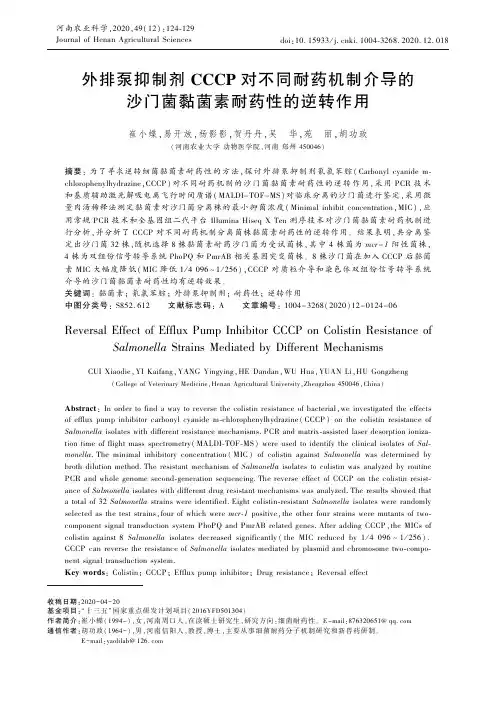
河南农业科学,2020,49(12):124-129Journal of Henan Agricultural Sciencesdoi :10.15933/ki.1004-3268.2020.12.018收稿日期:2020-04-20基金项目: 十三五 国家重点研发计划项目(2016YFD501304)作者简介:崔小蝶(1994-),女,河南周口人,在读硕士研究生,研究方向:细菌耐药性㊂E -mail:876320651@ 通信作者:胡功政(1964-),男,河南信阳人,教授,博士,主要从事细菌耐药分子机制研究和新兽药研制㊂E -mail:yaolilab@外排泵抑制剂CCCP 对不同耐药机制介导的沙门菌黏菌素耐药性的逆转作用崔小蝶,易开放,杨影影,贺丹丹,吴㊀华,苑㊀丽,胡功政(河南农业大学动物医学院,河南郑州450046)摘要:为了寻求逆转细菌黏菌素耐药性的方法,探讨外排泵抑制剂氰氯苯腙(Carbonyl cyanide m-chlorophenylhydrazine ,CCCP )对不同耐药机制的沙门菌黏菌素耐药性的逆转作用,采用PCR 技术和基质辅助激光解吸电离飞行时间质谱(MALDI -TOF -MS )对临床分离的沙门菌进行鉴定,采用微量肉汤稀释法测定黏菌素对沙门菌分离株的最小抑菌浓度(Minimal inhibit concentration ,MIC ),应用常规PCR 技术和全基因组二代平台Illumina Hiseq X Ten 测序技术对沙门菌黏菌素耐药机制进行分析,并分析了CCCP 对不同耐药机制分离菌株黏菌素耐药性的逆转作用㊂结果表明,共分离鉴定出沙门菌32株,随机选择8株黏菌素耐药沙门菌为受试菌株,其中4株菌为mcr -1阳性菌株,4株为双组份信号转导系统PhoPQ 和PmrAB 相关基因突变菌株㊂8株沙门菌在加入CCCP 后黏菌素MIC 大幅度降低(MIC 降低1/4096~1/256),CCCP 对质粒介导和染色体双组份信号转导系统介导的沙门菌黏菌素耐药性均有逆转效果㊂关键词:黏菌素;氰氯苯腙;外排泵抑制剂;耐药性;逆转作用中图分类号:S852.612㊀㊀文献标志码:A㊀㊀文章编号:1004-3268(2020)12-0124-06Reversal Effect of Efflux Pump Inhibitor CCCP on Colistin Resistance ofSalmonella Strains Mediated by Different MechanismsCUI Xiaodie,YI Kaifang,YANG Yingying,HE Dandan,WU Hua,YUAN Li,HU Gongzheng(College of Veterinary Medicine,Henan Agricultural University,Zhengzhou 450046,China)Abstract :In order to find a way to reverse the colistin resistance of bacterial,we investigated the effects of efflux pump inhibitor carbonyl cyanide m-chlorophenylhydrazine(CCCP )on the colistin resistance of Salmonella isolates with different resistance mechanisms.PCR and matrix-assisted laser desorption ioniza-tion time of flight mass spectrometry(MALDI-TOF-MS)were used to identify the clinical isolates of Sal-monella .The minimal inhibitory concentration (MIC)of colistin against Salmonella was determined by broth dilution method.The resistant mechanism of Salmonella isolates to colistin was analyzed by routine PCR and whole genome second-generation sequencing.The reverse effect of CCCP on the colistin resist-ance of Salmonella isolates with different drug resistant mechanisms was analyzed.The results showed that a total of 32Salmonella strains were identified.Eight colistin-resistant Salmonella isolates were randomly selected as the test strains,four of which were mcr-1positive,the other four strains were mutants of two-component signal transduction system PhoPQ and PmrAB related genes.After adding CCCP,the MICs of colistin against 8Salmonella isolates decreased significantly (the MIC reduced by 1/4096~1/256).CCCP can reverse the resistance of Salmonella isolates mediated by plasmid and chromosome two-compo-nent signal transduction system.Key words :Colistin;CCCP;Efflux pump inhibitor;Drug resistance;Reversal effect㊀第12期崔小蝶等:外排泵抑制剂CCCP对不同耐药机制介导的沙门菌黏菌素耐药性的逆转作用㊀㊀沙门菌是一种人畜共患病原菌,给我国养殖业造成了巨大威胁㊂黏菌素(Colistin,COL)是治疗动物革兰氏阴性杆菌感染包括沙门菌病的常用有效药物㊂但随着其广泛使用,沙门菌对其耐药性也日益严重,给临床治疗带来了巨大的挑战㊂目前,已阐明的细菌对黏菌素耐药的机制主要有2种[1-2]:一是染色体介导的2个双组分信号转导系统(TCS)PhoPQ 和PmrAB(包括2个调控元件MgrB和PmrD)㊂Pm-rAB和PhoPQ中的基因发生突变,可使其下游的pmrC㊁pmrH等脂多糖(LPS)修饰相关基因的表达量上升,进而使细菌的类脂A发生4-氨基-4-脱氧-L-阿拉伯糖(Ara4N)或磷酸乙醇胺(pENT)修饰,使细菌表面的负电荷减少,降低了细菌对阳离子多肽黏菌素的吸附而产生耐药[3]㊂mgrB基因的缺失㊁变异㊁插入或截断失活,可引起PhoPQ系统的上调,进而导致下游pmrHFIJKLM基因表达的上调,最后导致对黏菌素耐药[4-5]㊂二是质粒介导的黏菌素耐药基因mcr㊂2015年,我国首次在动物源大肠埃希菌中发现了质粒介导的黏菌素耐药基因mcr-1[6]㊂随后,7个新的质粒介导的黏菌素耐药基因mcr2 mcr8也陆续在中国或欧洲国家被发现[7]㊂细菌外排泵对药物的外排作用是细菌对多种抗生素耐药的重要机制之一㊂许多外排泵可以降低细菌对抗菌药物的敏感性,如MexXY-OprM和AcrAB-TolC[8-9]㊂外排泵抑制剂(Efflux pump inhibitors, EPIs)可通过不同的机制失活或抑制AcrAB-TolC 等外排泵的功能㊂已发现的EPIs有多种,氰氯苯腙(CCCP)是一种抑制质子转运的解偶联剂,可以阻断主动外排系统能量来源,使药物在细菌体内的蓄积量增加,恢复细菌对药物的敏感性[10]㊂已证明CCCP对氟喹诺酮类㊁四环素类等抗菌药物的抗菌作用有增强作用[11]㊂近年的研究表明,CCCP能逆转肺炎克雷伯菌㊁大肠杆菌等对黏菌素的耐药性[12-14],但对动物源沙门菌黏菌素耐药性的影响尚未见报道㊂为此,观察CCCP对不同耐药机制的沙门菌分离菌株黏菌素耐药性的逆转作用,为寻找控制耐黏菌素沙门菌感染的联合用药措施提供理论依据㊂1㊀材料和方法1.1㊀材料1.1.1㊀菌株㊀供试菌株:2018 2019年从河南省部分养殖场的疑似沙门菌病的病死鸡肝脏样品分离到58株沙门菌,从中随机选择8株黏菌素耐药沙门菌为受试菌株㊂全基因组测序对照菌鼠伤寒沙门菌标准株(CVCC®541)购自中国兽药监察所;质控菌株为大肠埃希菌ATCC®25922,购自中国普通微生物菌种保存中心㊂1.1.2㊀主要试剂和药品㊀主要培养基LB肉汤㊁LB 琼脂㊁SS琼脂㊁MHB肉汤培养基等均购于青岛海博生物技术有限公司㊂琼脂糖(Takara公司,Japan)㊁2ˑEs Taq MasterMix(北京康为世纪生物技术有限公司)㊁50ˑTAE(北京索莱宝生物科技有限公司)㊁荧光染料溴化乙锭(上海生工生物技术服务有限公司)㊂细菌基因组DNA提取试剂盒(DP302)购于天根生化科技(北京)有限公司㊂CCCP(含量ȡ97%)购于美国Sigma公司㊂黏菌素(效价23988u/mg)购于河北圣雪大成唐山制药有限责任公司㊂1.2㊀试验方法1.2.1㊀供试菌株分离㊀将221份病料分别均匀涂布于SS培养基上,37ħ培养16~18h,挑取单个菌落接种于LB肉汤,放于水浴恒温振荡器12h,再次接种于SS培养基,如此反复直至SS培养基上均为纯黑色的单个菌落㊂挑取单个的黑色菌落接种于5mL的LB肉汤中,放置于37ħ摇床中180r/min 振荡培养,16~18h后取出备用㊂1.2.2㊀供试菌株鉴定㊀将分离到的菌株采用裂解法提取基因组DNA㊂参考文献[15-16]的引物及反应条件,分别进行沙门氏菌侵袭基因invA和16S rRNA的PCR扩增鉴定㊂取PCR反应产物1%琼脂糖凝胶电泳,溴化乙锭染色,凝胶系统下观察结果㊂PCR产物送上海生工生物技术服务有限公司进行测序分析㊂PCR阳性菌株同时进行基质辅助激光解吸电离飞行时间质谱(MALDI-TOF/MS)鉴定㊂引物由上海生工生物技术服务有限公司合成㊂1.2.3㊀供试药液的配制及保存㊀用分析天平称取黏菌素,用漩涡振荡仪进行振荡混匀制备质量浓度为5120mg/L抗菌药物原液㊂用二甲基亚砜(DM-SO)制备5000mg/L质量浓度的CCCP原液㊂采用0.22μm的滤膜进行过滤除菌,储存于4ħ以备后续使用㊂1.2.4㊀CCCP对沙门菌黏菌素耐药性的逆转作用㊀用微量肉汤稀释法[17]测定黏菌素及其添加外排泵抑制剂CCCP(终质量浓度为5mg/L)对随机选择的8株黏菌素耐药沙门分离株的最小抑菌浓度(MIC)㊂以MHB肉汤㊁MHB肉汤+菌株㊁MHB肉汤+菌株+5mg/LCCCP为对照㊂质控菌株为大肠埃希菌ATCC25922㊂重复操作3次,药敏结果判断依据CLSI标准[17]:黏菌素MICȡ4mg/L为耐药,黏菌素MIC2~4mg/L为中介,黏菌素MIC<2mg/L为521河南农业科学第49卷敏感㊂1.2.5㊀黏菌素的耐药机制1.2.5.1㊀质粒介导的黏菌素耐药基因mcr 的检测㊀以随机选择的8株黏菌素耐药沙门菌基因组DNA 为模板,参考文献[7,18]的引物及反应条件进行PCR 反应和测序分析,检测质粒介导的黏菌素耐药基因mcr1 mcr8㊂同时进行8株沙门菌的全基因组测序:用基因组DNA 提取试剂盒提取8株细菌的基因组DNA,操作步骤按照天根生化科技(北京)有限公司的提取试剂盒说明书方法进行㊂提取的基因组DNA 送安诺优达基因科技(北京)有限公司进行测序,采用二代测序平台Illumina Hiseq X Ten 进行全基因组测序分析㊂使用FastQC 进行测序质控,SPAdes 进行序列的拼接组装,RAST (http://rast.)进行基因预测及功能注释㊂对上述2种测序结果中的mcr 序列与NCBI 数据库中的mcr 序列进行比对与分析㊂1.2.5.2㊀染色体介导的耐药机制分析㊀据上述测序结果,基于基因组学序列分析的方法,先将NCBI数据库中收录的鼠伤寒沙门菌标准株(CVCC ®541)完整测序序列下载,并构建本地数据库㊂再将双组份信号转导系统PhoPQ 和PmrAB 相关基因序列作为咨询序列,与上述构建好的本地数据库进行比对分析㊂同时参照NCBI 数据库中已提交的基因序列合成引物,PCR 扩增phoP ㊁phoQ ㊁pmrA ㊁pmrB ㊁mgrB ㊁pmrD 和pmrC 全基因序列,引物序列见表1㊂PCR 产物送上海生工生物技术服务有限公司进行测序分析㊂表1㊀PhoPQ 和PmrAB 双组份相关基因的引物序列Tab.1㊀Primer sequences of PhoPQ and PmrAB two component related genes目的基因Target gene引物名称Primer name引物序列(5ᶄ 3ᶄ)Primer sequences(5ᶄ 3ᶄ)产物大小/bp Product sizephoP phoP -F GTGACTCTGGTCGACGAACT 825phoP -R GCGCAATTCAAAAAGATATCCT phoQ phoQ -F GATGCTTCAGCTGTATCCGG 1614phoQ -R ATTCCTCTTTCTGTGTGGGATGC pmrA pmrA -F TCAACAGCGTTATCAGGTGG 834pmrA -R TTAGCTTTCCTCAGTGGCAA pmrB pmrB -F ACAACTGGGATAACGAACCC 1214pmrB -R TTATGCCTTTTTCAACAGCACC mgrB mgrB -F CCGCAGCGTTCACTTTACTTCCCAC 664mgrB -R GACGGCGTAACAACGCGTTTTGCC pmrD pmrD -F ACTGTCAGCGCCATAAATGG 518pmrD -R TCATGATGGCTTGCGCGTCA pmrCpmrC -F TGAATTACAACCGTATTCAC 1839pmrC -RTCATTCGCTTAGTCTCCTGCA2㊀结果与分析2.1㊀菌株的分离与鉴定221份病死鸡肝脏样品中有58份在SS 培养基上长出半透明或不透明以及黑色的圆形菌落;58份样品的侵袭基因invA (图1)和16S rRNA 中,有32份可以扩增出与阳性对照片段大小一样的特异性条带㊂PCR 产物测序结果利用DNA Star 软件与NCBI数据库中的序列进行比对,确定为沙门菌invA 和16S rRNA 基因序列㊂MALDI -TOF -MS 鉴定结果经软件分析后,与数据库中的沙门菌同源性达到98%以上㊂由以上结果可以判断,58份疑似样品分离的菌株中有32株为沙门菌㊂2.2㊀CCCP 对分离沙门菌菌株黏菌素耐药性的逆转作用药敏结果表明,32株沙门菌中共有19株对黏菌素耐药,随机挑选8株耐药菌进一步观察了CCCP 与黏菌素联用的MIC(表2)㊂8株沙门分离株的编号为SH01 08㊂从表2可以看出,黏菌素对质控菌ATCC ®25922的MIC 在CLSI 规定的范围内㊂加入外排泵抑制剂CCCP 后,9株细菌对黏菌素的敏感性明显增强,CCCP 增强了黏菌素的抗菌活性,降低了黏菌素对不同耐药机制菌株(mcr -1阳性㊁P hoP Q 和P mrAB 相关基因的突变)的MIC㊂4株mcr -1阳性菌株的MIC 平均降低了1/832,4株mcr -1阴性菌株的MIC 平均降低了1/1920㊂CCCP 能逆转所有菌株对黏菌素的耐药性,黏菌素耐药率由100%降低到了0㊂对照试验表明,CCCP 在5mg /L 质量浓度下对细菌没有抑制作用㊂621㊀第12期崔小蝶等:外排泵抑制剂CCCP对不同耐药机制介导的沙门菌黏菌素耐药性的逆转作用M:DNA Marker 2000;1 8:菌株样品;9:阳性对照;10:阴性对照M:DNA Marker 2000;1 8:Strain sample;9:Positive control;10:Negative control图1㊀invA 基因扩增结果Fig.1㊀invA gene amplification results表2㊀分离沙门菌菌株加入CCCP 前后的黏菌素MIC Tab.2㊀The colistin MIC of isolated Salmonellastrain before and after adding CCCP菌株编号Strain numbermcr -1COL CCCP +COL MIC 变化MIC change25922-1/21/40961/2048SH01+161/641/1024SH02-81/1281/1024SH03-321/1281/4096SH04+161/641/1024SH05-161/1281/2048SH06+41/641/256SH07-321/161/512SH08+41/2561/1024㊀注:SH01 08为随机挑选的沙门菌菌株;mcr -1基因下的 - 表示菌株此基因阴性,下同㊂㊀Note:SH01 08were randomly selected Salmonella strains;The -under the mcr-1gene means that the strain is negative for mcr-1.The same below.2.3㊀黏菌素的耐药机制在8株随机选择的黏菌素耐药沙门菌中,如图2所示,有4株沙门菌可见与mcr -1阳性对照一致的309bp 的扩增片段,未扩增到其他亚型的黏菌素耐药基因mcr2 mcr8㊂全基因组二代测序检测mcr1 mcr8结果与PCR 扩增结果一致㊂对测序结果序列进行比对和分析,结果显示,所检测的mcr -1序列与NCBI 数据库中的沙门菌mcr -1序列(Gen-Bank:MN873698)同源性达到99%以上,确定为mcr -1阳性菌株㊂M:DNA Marker 2000;1 4:菌株样品;5:阳性对照;6:阴性对照M:DNA Marker 2000;1 4:Strain sample;5:Positive control;6:Negative control图2㊀mcr -1耐药基因扩增结果Fig.2㊀mcr-1resistance gene amplification results8株沙门菌全基因组二代测序检测mcr -1与双组份信号转导系统PhoPQ 和PmrAB 相关基因编码的氨基酸突变见表3㊂mcr -1阳性菌株SH04,同时存在mgrB 基因编码的氨基酸Y31D 突变㊂与鼠伤寒沙门菌标准株(CVCC ®541)比较,4株mcr -1阴性菌株中,菌株SH02的pmrB 蛋白有2处氨基酸突变,分别是R248P 和E292K;mgrB 蛋白提前1个色表3㊀分离菌株全基因组测序中部分耐药基因编码的氨基酸突变结果Tab.3㊀Results of amino acid mutations encoded by some resistant genes in whole-genome sequencing of isolated strains菌株编号Strain numberCOL MICmcr -1pmrB mgrB pmrC SH0116+---SH028-R248P E292K 提前1个色氨酸(W)终止-SH0332---L77P㊁A159V㊁G232S㊁E415QSH0416+-Y31D -SH0516--提前1个色氨酸(W)终止L77P㊁A159V㊁G232S㊁E415QSH064+---SH0732--F44L㊁I58F-SH084+---㊀注:pmrB ㊁mgrB ㊁pmrC 基因下的 - 表示菌株此基因编码的氨基酸无突变㊂㊀Note:The - under the pmrB ,mgrB and pmrC genes means that the strain has no amino acid mutation.721河南农业科学第49卷氨酸(W)终止翻译㊂菌株SH03的pmrC蛋白有4处氨基酸突变:L77P㊁A159V㊁G232S㊁E415Q㊂菌株SH05的mgrB蛋白提前1个色氨酸(W)终止翻译;同时pm-rC蛋白的突变与菌株SH02相同㊂菌株SH07的mgrB 蛋白有2处氨基酸突变:F44L㊁I58F㊂未发现phoP㊁phoQ㊁pmrA和pmrD中的氨基酸变异㊂PCR测序结果与全基因组二代测序结果一致㊂3㊀结论与讨论本研究表明,黏菌素对8株耐黏菌素的沙门菌分离菌株的MIC介于4~32mg/L,黏菌素联合CCCP后,与单药相比MIC明显下降(下降了1/4096~1/256)㊂CCCP增强了耐药菌对黏菌素的敏感性,逆转了所有沙门菌的黏菌素耐药性㊂黏菌素的耐药机制结果显示, 8株耐黏菌素分离菌有4株为mcr-1阳性,其中,菌株SH04同时存在双组份信号转导系统PhoPQ和PmrAB 相关基因突变(mgrB变异);其余4株均为PhoPQ和PmrAB相关基因突变菌株㊂药敏试验结果表明,CCCP 对不同耐药机制的沙门菌的黏菌素MIC的影响并无差异,对8株沙门菌黏菌素耐药性均有逆转作用㊂CCCP作为外排泵抑制剂时的质量浓度一般在10~ 20mg/L[11-13],而本研究中10~20mg/L的CCCP质量浓度对于沙门菌有抑制作用,故本试验选用质量浓度为5mg/L,发现该质量浓度下CCCP本身对沙门菌没有抑制作用㊂可见,CCCP对黏菌素抗菌增强作用并不是由于其本身的抗菌活性,而是由于其抑制外排泵而发挥逆转耐药性的作用㊂细菌的主动外排系统是细菌产生多重耐药的重要机制㊂外排泵系统已经被报道在黏菌素耐药中能够发挥作用,如大肠杆菌中的AcrAB-TolC[19]和铜绿假单胞菌中的MexXY-OprM[8]㊂EPIs已经用于评估外排泵系统的上调对黏菌素抗性的作用㊂EPI 对粘菌素抗性的影响因EPI类型而异㊂PABN和1-(1-萘甲基)-哌嗪(NMP)是被认为与AcrB作用位点中的药物竞争起作用的EPI[20],但是未能恢复对黏菌素耐药的革兰氏阴性菌的黏菌素敏感性[14,21]㊂然而,非特异性的EPIs CCCP和2,4-二硝基苯酚(DNP)在恢复黏菌素敏感性方面表现出良好的活性[14,21]㊂有研究表明,外排泵抑制剂CCCP能显著降低黏菌素对多种革兰氏阴性菌的MIC[13]㊂由于CCCP作用于外排泵的能量源-质子动力,并能调节膜内其他蛋白质的活性,因此很难确定CCCP发挥降低黏菌素抗性的机制㊂黏菌素是通过破坏阴性菌带负电荷的外膜而降低细胞膜稳定性,使细胞内重要物质外流产生杀菌作用[22]㊂因此,CCCP增强黏菌素抗菌活性并不是通过常规的降低细胞内药物外排㊁增加细胞内浓度达到的,而是通过其他间接的机制来增加细菌对黏菌素敏感性㊂NI等[14]报道,CCCP对黏菌素活性的影响可能是由于细胞膜上负电荷的再生引起㊂PARK等[21]发现,CCCP引起的ATP生成减少可能是这些细胞中黏菌素活性增加的原因㊂为了更好地解释这一机制的复杂作用原理,需要进一步研究外排泵抑制黏菌素抗性的机制,特别是通过描述外排泵基因及其在不同耐药机制的耐药菌株中的表达㊂本研究结果表明,CCCP对不同耐药机制的耐黏菌素沙门菌的黏菌素MIC的影响并无差异,说明CCCP是一种增强黏菌素活性的广谱增效剂㊂将抗生素与增强其活性的增效剂结合,是解决抗生素耐药和耐药菌感染的重要策略㊂合理联合用药对于增强疗效㊁扩大抗菌谱㊁减少用量㊁降低或避免不良反应㊁减少或延缓耐药菌株的产生都具有重要意义㊂本研究发现,CCCP能广谱逆转分离菌黏菌素的耐药性,但CCCP由于安全性问题,尚不能临床应用㊂由于抑制外排泵能有效逆转黏菌素耐药性,故选用外排泵抑制剂与黏菌素联合,是增强后者抗菌活性的有效措施,寻找新的有效且更安全的外排泵抑制剂,对克服黏菌素的耐药性以及研制复方制剂㊁开发新型抗菌剂具有重要意义㊂参考文献:[1]㊀OLAITAN A O,MORAND S,ROLAIN J M.Mechanismsof polymyxin resistance:Acquired and intrinsic resistancein bacteria[J].Frontiers in Microbiology,2014,5:643-660.[2]㊀BARON S,HADJADJ L,ROLAIN J M,et al.Molecularmechanisms of polymyxin resistance:Knowns and un-knowns[J].Internatial Journal of Antimicrobial Agents,2016,48(6):583-591.[3]㊀HJORT K,NICOLOFF H,ANDERSSON D I.Unstabletandem gene amplification generates heteroresistance(var-iation in resistance within a population)to colistin in Sal-monella enterica[J].Molecular Microbiology,2016,102(2):274-289.[4]㊀ANTONIO C,TOMMASO G,MARCO M D,et al.MgrBinactivation is a common mechanism of colistin resistancein KPC-producing Klebsiella pneumoniae of clinical origin[J].Antimicrobial Agents and Chemotherapy,2014,58(10):696-703.[5]㊀JAYOL A,POIREL L,BRINK A,et al.Resistance to co-listin associated with a single amino acid change in pro-tein PmrB among Klebsiella pneumoniae isolates of world-821㊀第12期崔小蝶等:外排泵抑制剂CCCP对不同耐药机制介导的沙门菌黏菌素耐药性的逆转作用wide origin[J].Antimicrobial Agents and Chemother,2014,58(8):4762-4766.[6]㊀LIU Y Y,WANG Y,WALSH T R,et al.Emergence ofplasmid-mediated colistin resistance mechanism mcr-1inanimals and human beings in China:A microbiologicaland molecular biological study[J].Lancet Infectious Dis-eases,2016,16(2):161-168.[7]㊀WANG X M,WANG Y,ZHOU Y,et al.Emergence of anovel mobile colistin resistance gene,mcr-8,in NDM-pro-ducing Klebsiella pneumoniae[J].Emerging Microbes&Infections,2018,7(1):122-131.[8]㊀PEREZ A,POZA M,FERNANDEZ A,et al.Involvementof the AcrAB-tolC efflux pump in the resistance,fitness,and virulence of enterobacter cloacae[J].AntimicrobialAgents&Chemotherapy,2012,56(4):2084-2090. [9]㊀TELKE A A,OLAITAN A O,MORAND S,et al.soxRSinduces colistin hetero-resistance in Enterobacter asburiaeand Enterobacter cloacae by regulating the AcrAB-tolC ef-flux pump[J].Journal of Antimicrobial Chemotherapy,2017,72(10):2715-2721.[10]㊀ZHANG Z,LIU Z Q,ZHENG P Y,et al.Influence of ef-flux pump inhibitors on the multidrug resistance of Heli-cobacter pylori[J].World Journal of Gastroenterology,2010,16(10):1279-1284.[11]㊀LI Y F,JIANG H X,XIANG R,et al.Effects of two ef-flux pump inhibitors on the drug susceptibility of Rieme-rella anatipestifer isolates from China[J].Journal ofIntegrative Agriculture,2016,15(4):929-933. [12]㊀JOHN O S,AMOAKO D G.Carbonyl cyanide m-chloro-phenylhydrazine(CCCP)reverses resistance to colistin,but not to carbapenems and tigecycline in multidrug-re-sistant Enterobacteriaceae[J].Frontiers in Microbiology,2017,(8):228-236.[13]㊀BARON S A,ROLAIN J M.Efflux pump inhibitor CCCPto rescue colistin susceptibility in mcr-1plasmid-media-ted colistin-resistant strains and Gram-negative bacteria[J].The Journal of Antimicrobial Chemotherapy,2018,73(7):1862-1871.[14]㊀NI W,LI Y,GUAN J,et al.Effects of efflux pump inhib-itors on colistin resistance in multidrug resistant Gram-negative bacteria[J].Antimicrobial Agents Chemother,2016,60(5):3215-3218.[15]㊀马彩珲,黄慧,陈丽鹏,等.鼠伤寒沙门菌ST1920株cpxR基因缺失株的构建及其对小鼠LD(50)的影响[J].中国兽医学报,2016,36(3):437-442.MA C H,HUANG H,CHEN L P,et al.Construction ofcpxR gene deletion strain ST1920of Salmonella isolateand its effect on mouse LD(50)[J].Chinese Journal ofVeterinary Science,2016,36(3):437-442. [16]㊀WEISBURG W G,BARNS S M,PELLETIER D A,et al.16S ribosomal DNA amplification for phylogenetic study[J].Journal of Bacteriology,1991,173(2):697-703.[17]㊀TSUKATANI T,SUENAGA H,SHIGA M,et par-ison of the WST-8colorimetric method and the CLSIbroth microdilution method for susceptibility testingagainst drug-resistant bacteria[J].Journal of Microbio-logical Methods,2012,90(3):160-166. [18]㊀REBELO A R,BORTOLAIA V,KJELDGAARD J S,etal.Multiplex PCR for detection of plasmid-mediated co-listin resistance determinants,mcr-1,mcr-2,mcr-3,mcr-4and mcr-5for surveillance purposes[J].Eurosurveil-lance,2018,23(6):17-27.[19]㊀WARNER D M,LEVY S B.Different effects of transcrip-tional regulators MarA,SoxS and Rob on susceptibility ofEscherichia coli to cationic antimicrobial peptides(CAMPs):Rob-dependent CAMP induction of the mar-RAB operon[J].Microbiology,2010,156:570-578.[20]㊀OPPERMAN T J,NGUYEN S T.Recent advances to-ward a molecular mechanism of efflux pump inhibition[J].Frontiers in Microbiology,2015,6:421-436. [21]㊀PARK Y K,KO K S.Effect of carbonyl cyanide3-chlo-rophenylhydrazone(CCCP)on killing Acinetobacter bau-mannii by colistin[J].Journal of Microbiology,2015,53(1):53-59.[22]㊀SCHINDLER M,OSBORN M J.Interaction of divalentcations and polymyxin B with lipopolysaccharide[J].Bi-ochemistry,1979,18(20):4425-4430.921。
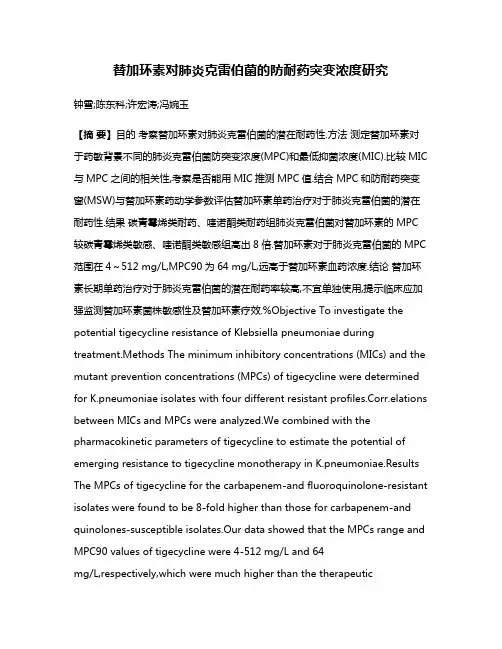
替加环素对肺炎克雷伯菌的防耐药突变浓度研究钟雪;陈东科;许宏涛;冯婉玉【摘要】目的考察替加环素对肺炎克雷伯菌的潜在耐药性.方法测定替加环素对于药敏背景不同的肺炎克雷伯菌防突变浓度(MPC)和最低抑菌浓度(MIC).比较MIC 与MPC之间的相关性,考察是否能用MIC推测MPC值.结合MPC和防耐药突变窗(MSW)与替加环素药动学参数评估替加环素单药治疗对于肺炎克雷伯菌的潜在耐药性.结果碳青霉烯类耐药、喹诺酮类耐药组肺炎克雷伯菌对替加环素的MPC 较碳青霉烯类敏感、喹诺酮类敏感组高出8倍.替加环素对于肺炎克雷伯菌的MPC 范围在4~512 mg/L,MPC90为64 mg/L,远高于替加环素血药浓度.结论替加环素长期单药治疗对于肺炎克雷伯菌的潜在耐药率较高,不宜单独使用,提示临床应加强监测替加环素菌株敏感性及替加环素疗效.%Objective To investigate the potential tigecycline resistance of Klebsiella pneumoniae during treatment.Methods The minimum inhibitory concentrations (MICs) and the mutant prevention concentrations (MPCs) of tigecycline were determined for K.pneumoniae isolates with four different resistant profiles.Corr.elations between MICs and MPCs were analyzed.We combined with the pharmacokinetic parameters of tigecycline to estimate the potential of emerging resistance to tigecycline monotherapy in K.pneumoniae.Results The MPCs of tigecycline for the carbapenem-and fluoroquinolone-resistant isolates were found to be 8-fold higher than those for carbapenem-and quinolones-susceptible isolates.Our data showed that the MPCs range and MPC90 values of tigecycline were 4-512 mg/L and 64mg/L,respectively,which were much higher than the therapeuticconcentrations of tigecycline in serum and tissues.Conclusions Long-term tigecycline monotherapy may predispose the emergence of resistance in K.pneumoniae,which is not recommended.It is desirable to carry out ongoing monitoring of K.pneumoniae susceptibility and tigecycline treatment effect.【期刊名称】《中国感染与化疗杂志》【年(卷),期】2017(017)006【总页数】5页(P643-647)【关键词】替加环素;肺炎克雷伯菌;防耐药突变浓度【作者】钟雪;陈东科;许宏涛;冯婉玉【作者单位】北京大学人民医院药剂科,北京100044;北京医院检验科;北京医院检验科;北京大学人民医院药剂科,北京100044【正文语种】中文【中图分类】R978.1近年来耐药肺炎克雷伯菌的检出率逐年增高,产ESBL和AmpC酶及碳青霉烯酶(KPC-2酶)肺炎克雷伯菌的抗生素选择已成为抗感染治疗面临的严峻挑战。
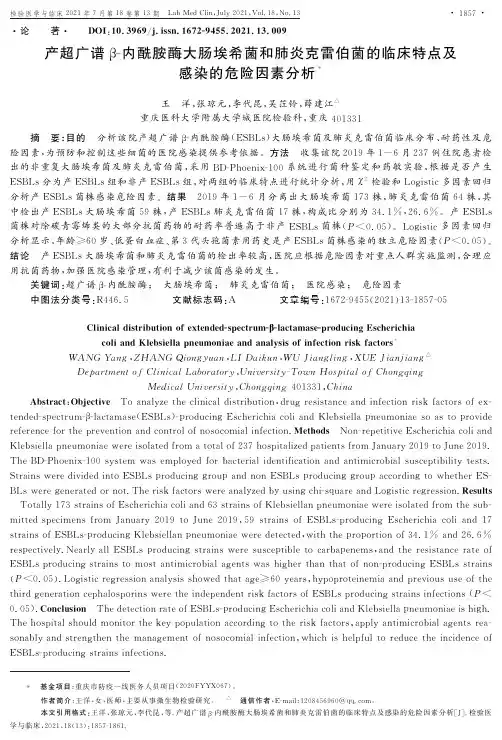
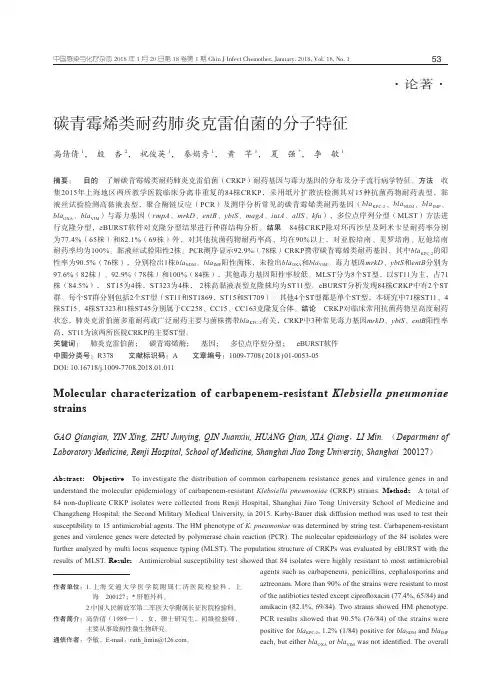
·论著·作者单位:1. 上海交通大学医学院附属仁济医院检验科,上海 200127;* 肝脏外科。
2.中国人民解放军第二军医大学附属长征医院检验科。
作者简介: 高倩倩(1989—),女,硕士研究生,初级检验师,主要从事致病性微生物研究。
通信作者:李敏,E-mail :ruth_limin@ 。
碳青霉烯类耐药肺炎克雷伯菌的分子特征高倩倩1, 殷 杏2, 祝俊英1, 秦娟秀1, 黄 芊1, 夏 强*, 李 敏1摘要: 目的 了解碳青霉烯类耐药肺炎克雷伯菌(CRKP )耐药基因与毒力基因的分布及分子流行病学特征。
方法 收集2015年上海地区两所教学医院临床分离非重复的84株CRKP ,采用纸片扩散法检测其对15种抗菌药物耐药表型,黏液丝试验检测高黏液表型,聚合酶链反应(PCR )及测序分析常见的碳青霉烯类耐药基因(bla KPC-2、bla NDM 、bla IMP 、bla OXA 、bla VIM )与毒力基因(rmpA 、mrkD 、entB 、ybtS 、magA 、iutA 、allS 、kfu ),多位点序列分型(MLST )方法进行克隆分型,eBURST 软件对克隆分型结果进行种群结构分析。
结果 84株CRKP 除对环丙沙星及阿米卡星耐药率分别为77.4%(65株)和82.1%(69株)外,对其他抗菌药物耐药率高,均在90%以上,对亚胺培南、美罗培南、厄他培南耐药率均为100%。
黏液丝试验阳性2株。
PCR 测序显示92.9%(78株)CRKP 携带碳青霉烯类耐药基因,其中bla KPC-2的阳性率为90.5%(76株),分别检出1株bla NDM 、bla IMP 阳性菌株,未检出bla OXA 和bla VIM 。
毒力基因mrkD 、ybtS 和entB 分别为97.6%(82株)、92.9%(78株)和100%(84株),其他毒力基因阳性率较低。
MLST 分为8个ST 型,以ST11为主,占71株(84.5%), ST15为4株,ST323为4株, 2株高黏液表型克隆株均为ST11型。
REVIEWCorrelationbetweenantimicrobialresistanceandvirulenceinKlebsiellapneumoniae
C.Hennequin1,2,6&F.Robin1,3,4,5,6
Received:13November2015/Accepted:14December2015/Publishedonline:30December2015#Springer-VerlagBerlinHeidelberg2015
AbstractKlebsiellapneumoniaeisresponsibleforawiderangeofinfections,includingurinarytractinfections,pneu-monia,bacteremia,andliverabscesses.Inadditiontosuscep-tibleclinicalisolatesinvolvedinnosocomialinfections,multidrug-resistant(MDR)andhypervirulent(hvKP)strainshaveevolvedseparatelyindistinctclonalgroups.Therapidgeographicspreadoftheseisolatesisofparticularconcern.However,westillknowlittleaboutthevirulenceofK.pneumoniaeexceptforhvKP,whosesecretsarebeginningtoberevealed.ThetreatmentofK.pneumoniaeinfectionsisthreatenedbytheemergenceofantimicrobialresistance.Thedisseminationofresistanceisassociatedwithgeneticmobileelements,suchasplasmidsthatmayalsocarryvirulencede-terminants.Aproficientpathogenshouldbevirulent,resistanttoantibiotics,andepidemic.However,theinterplaybetweenresistanceandvirulenceispoorlyunderstood.Here,were-viewcurrentknowledgeonthetopic.
IntroductionKlebsiellapneumoniaessp.pneumoniaeisthecausativeagentofavarietyofdiseases,includingurinarytractandsofttissueinfections,bacteremia,andpneumonia.Indevelopedcoun-tries,K.pneumoniaehastraditionallybeenconsideredasanopportunisticpathogenresponsiblefornosocomialinfections[1].However,overthepastthreedecades,adistinctivesyn-dromeofcommunity-acquiredinvasiveinfections,primarilyintheformofpyogenicliverabscesses,hasemerged[2].ThisinvasivesyndromehasbeenreportedmostlyinAsia,butanincreasingnumberofcaseshaveappearedworldwide[3].Theseinfectionsarecausedbyhypervirulent(hvKP)isolates,mainlyofserotypesK1andK2.SerotypeK1strainsbelongtoparticularclonessuchasclonalcomplex23(CC23),compris-ingST23andST57[4].SerotypeK2strainsbelongtoseveralsequencetypes(STs),someofwhicharelinkedtohypervirulence,suchasST86,ST375,andST380.IsolatesbelongingtoST57,ST65,andST375havebeeninvolvedininvasiveinfections[5].Inparallel,K.pneumoniaeclinicalisolateshaveacquiredincreasinglyhighlevelsofantimicrobialdrugresistance.Forexample,theratesofmultidrug-resistant(MDR),extensivelydrug-resistant(XDR),andpandrug-resistant(PDR)isolatesofK.pneumoniaewere61.4%,22%,and1.8%,respectively,foraperiodof14monthsbetween2010and2011inhospitalsinBeijing,China[6].Thismakesthemdifficulttoeradicateandhasledtotheirrapidspreadinhospitals.KlebsiellapneumoniaebelongstotheESKAPEgroup(Enterococcusfaecium,Staphylococcusaureus,Klebsiellapneumoniae,Acinetobacterbaumannii,Pseudomonasaeruginosa,andEnterobacterspecies),whichcausesmostnosocomialinfec-tionsinUShospitals[7].KlebsiellapneumoniaeBescapes^antibiotictreatmentbybecomingresistant.MostMDRK.pneumoniaeisolates,whichproducecarbapenemases
*F.Robinfrobin@chu-clermontferrand.fr
1LaboratoiredeBactériologie,CHUClermont-Ferrand,58,rue
Montalembert,63003Clermont-Ferrand,France
2Clermont-Université,UMRCNRS6023,Laboratoire
Microorganismes:GénomeEnvironnement(LMGE),Universitéd’Auvergne,Clermont-Ferrand,France
3Clermont-Université,Universitéd’Auvergne,M2iSH,
Clermont-Ferrand,France
4INSERM,U1071,63001Clermont-Ferrand,France
5INRAUSC2018,63001Clermont-Ferrand,France
6LaboratoireassociéRésistancedesEntérobactéries
BLSE/Céphalosporinases,CentreNationaldeRéférenceRésistanceauxAntibiotiques,Clermont-Ferrand,France
EurJClinMicrobiolInfectDis(2016)35:333–341DOI10.1007/s10096-015-2559-7(KPC)and/orextended-spectrumβ-lactamases(ESBLs)incombinationwithquinoloneandaminoglycosideresistance,belongtoparticularclones(e.g.,CC258comprisingST258,ST11,ST512,ST340,…,CC15,CC14)[5].MDRandhyper-virulentpopulationsofthisspecieswere,foralongtime,non-overlapping[5],butafewcasesofMDRhvKPhaverecentlybeenreported[8].ESBL-producingorganismswerefirstde-tectedinEurope,almostallinFrance[9].TheprevalenceofESBLsinKlebsiellarangedfromaslowas3%inSwedentoashighas34%inPortugalinintensivecareunits(ICUs).InNorthAmerica,6.1%ofK.pneumoniaeisolatesfromICUswereresistanttothird-generationcephalosporins.ESBLswerefoundin30–60%ofKlebsiellafromICUsinBrazil,Colombia,andVenezuela.36.1%ofK.pneumoniaeisolatescollectedinasingleSouthAfricanhospitalwereESBLpro-ducers.TheproportionoftheseisolatesinAustralianhospitalsisabout5%.RatesofESBLproductionbyK.pneumoniaeareaslowas5%inJapan,comparedwith20–50%elsewhereinAsia[9].KPC-positiveisolateshavealsospreadworldwide.Insomecountries,suchasIsrael,Greece,andColombia,casesareendemic,whileinothers,suchasAustralia,NewZealand,andCanada,theyareonlyimported[10].ThemainvirulencefactorsofK.pneumoniaearecapsule,fimbriae,lipopolysaccharides(LPS),andsiderophores(enterobactin,aerobactin,salmochelin,yersiniabactin),andef-flux[1].Somefactors,suchasfimbriae,capsule,enterobactins,andbiofilmformation,arefoundinalmostallisolatesandseemtobeattheoriginofclassicalpathogenesis.AnumberofputativevirulencefactorshavebeenassociatedwithhvKP,whileCC258isalmostentirelydevoidofviru-lencegenes[5].hvKPstrainsarecharacterizedbythepres-enceofRmpA(aregulatorofthemucoidphenotype)andaerobactin,whicharebothencodedbyalargevirulenceplas-mid[11].Additionalironacquisitionsystemssuchasyersiniabactin,whichisencodedbyanintegrativeandconjugativeelement(ICE)ICEKp1[12],andaregionassoci-atedwithallantoinmetabolism[13]havealsobeenassociatedwithspecifichvKPstrains.Generally,theacquisitionofanyoneofthesiderophoreclustersbyK.pneumoniaeisolatesincreasestheriskofsevereinfectioninhumans[14].BacteriacanacquireantimicrobialresistancebyDNAmu-tationorbyhorizontalgenetransfer[15].However,acquisi-tionofantibioticresistancecancarryafitnesscost,whichreducesthecompetitiveabilityofthebacteriaintheabsenceofantibiotics.Deletionormutationsinchromosomicgenesinvolvedinantimicrobialresistance(e.g.,porins)leadtoafitnesscost.Thiscostislowerforplasmidacquisition[16].Plasmidsplayacentralroleinthedisseminationandacquisi-tionofresistantdeterminantsandvirulentgenesinK.pneumoniae.Theyareresponsibleforsomanyparticularpropertiesofbacteriathatcertainauthorsconsiderthemasindependentorganisms[17].Klebsiellapneumoniaeispartic-ularlypermeabletoplasmids.Thestrainsusuallyharbormore